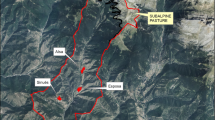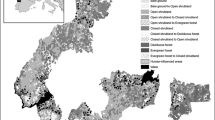Abstract
The Simien Mountains house several endangered and endemic wildlife species and provide important ecosystem services. Despite its regional environmental importance, the Simien Mountains are listed as World Heritage in Danger since 1997. This raised the need for an evaluation of landscape changes from before the establishment of the Simien Mountain National Park (SMNP) in 1969. For this purpose, historical terrestrial photographs (1966–2009) were re-analyzed from 2014 repeats, using an expert rating system with eight correspondents. An increase in forest was observed in the eastern and western edge of the SMNP at Sankaber and Imet Gogo (20–40%). In contrast, centrally in the SMNP (around Gich), the area covered with dense forest decreased with an estimated rate of −1.4% per decade. There is no significant effect (p > 0.05) of the boundary of the SMNP on woody vegetation change, because of continued anthropogenic pressure (especially wood cutting and livestock grazing) inside the SMNP. Also elevation and distance to scout camps do not affect rates of change, and however, the density of houses within 2.2 km (a proxy of population pressure) is able to explain 32% of the spatial distribution of woody vegetation decrease (p < 0.05). A subset of six repeated photographs, indicated an uplift of the treeline by more than 1 m year−1, in areas with low anthropogenic pressure. This is potentially related to increasing (average annual) temperature warming of up to 1.5 °C over the past 50 years. Overall, further reduction in anthropogenic pressure is urgent and crucial for recovery of the afro-alpine vegetation and the interrelated endangered wildlife in the Simien Mountains.



Similar content being viewed by others
References
Aerts R, November E, Behailu M, Deckers J, Hermy M, Muys B (2002) Forest rehabilitation: one approach to water conservation in central Tigray. Water Sci Technol 6:34–37
Alemayehu K, Dessie T, Gizaw S, Haile A, Mekasha Y (2011) Population dynamics of Walia ibex (Capra walie) at Simen Mountains National Park, Ethiopia. Afr J Ecol 49:292–300. doi:10.1111/j.1365-2028.2011.01264.x
Bewket W (2002) Land cover dynamics since the 1950s in Chemoga Watershed, Blue Nile Basin, Ethiopia. Mt Res Dev 22:263–269. doi:10.1659/0276-4741(2002)022[0263:LCDSTI]2.0.CO;2
Bonnefille R, Umer M (1994) Pollen-inferred climatic fluctuations in Ethiopia during the last 3000 years. Palaeogeogr Palaeoclimatol Palaeoecol 109:331–343. doi:10.1016/0031-0182(94)90183-X
Crimmins M, Crimmins T (2008) Monitoring plant phenology using digital repeat photography. Environ Manag 41:949–958. doi:10.1007/s00267-008-9086-6
de Mûelenaere S, Frankl A, Haile M, Poesen J, Deckers J, Munro N, Veraverbeke S, Nyssen J (2014) Historical landscape photographs for calibration of Landsat land use/cover in the Northern Ethiopian highlands. Land Degrad Dev 25:319–335. doi:10.1002/ldr.2142
Debonnet G, Melamari L, Bomhard B (2006) Reactive monitoring mission to Simen Mountains National Park. Joint World Heritage Centre-IUCN monitoring mission to Simen Mountains National Park World Heritage property. Paris, France
EWCA (2015) State of conservation report of the world natural Heritage site, Simen Mountains National Park (Ethiopia). Ethiopian Wildlife Conservation Authority, Addis Ababa, Ethiopia
Frankl A, Nyssen J, De Dapper M, Haile M, Billi P, Munro N, Deckers J, Poesen J (2011) Linking long-term gully and river channel dynamics to environmental change using repeat photography (Northern Ethiopia). Geomorphology 129:238–251. doi:10.1016/j.geomorph.2011.02.018
Frankl A, Poesen J, Deckers J, Haile M, Nyssen J (2012) Gully head retreat rates in the semi-arid highlands of Northern Ethiopia. Geomorphology 173–174:185–195. doi:10.1016/j.geomorph.2012.06.011
Friis I, Ryding O (2001) Biodiversity research in the Horn of Africa region. In: Proceedings of the third international symposium on the flora of Ethiopia and Eritrea. Carlsberg Academy, Copenhagen. Biol Skr. 54
Geist HJ, Lambin EF (2001) What drives tropical deforestation? A meta-analysis of proximate and underlying causes of deforestation based on subnational case study evidence. LUCC report series 4. Louvain-la-Neuve, Belgium
Goudie A (2006) The human impact on the natural environment: past, present and future, 6th edn. Blackwell Publishing, Oxford
Hall FC (2001) Ground-based photographic monitoring. Pacific Northwest Research Station, Portland
Harsch MA, Hulme PE, McGlone MS, Duncan RP (2009) Are treelines advancing? A global meta-analysis of treeline response to climate warming. Ecol Lett 12:1040–1049. doi:10.1111/j.1461-0248.2009.01355.x
Hendrickx H, Jacob M, Frankl A, Guyassa E, Nyssen J (2015) Quaternary glacial and periglacial processes in the Ethiopian highlands in relation to the current afro-alpine vegetation. Z Geomorphol 59:37–57. doi:10.1127/0372-8854/2014/0128
Holtmeier FK, Broll G (2005) Sensitivity and response of northern hemisphere altitudinal and polar treelines to environmental change at landscape and local scales. Glob Ecol Biogeogr 14:395–410. doi:10.1111/j.1466-822X.2005.00168.x
Holtmeier FK, Broll G (2007) Treeline advance—driving processes and adverse factors. Landsc Online 1:1–32. doi:10.3097/LO.200701
Houghton R (1994) The worldwide extent of land-use change. Bioscience 44:305–313. doi:10.2307/1312380
Hurni H (1988) Degradation and conservation of the resources in the Ethiopian highlands. Mt Res Dev 8:123–130. doi:10.2307/3673438
Hurni H (2005) Decentralised development in remote areas of the Simen Mountains, Ethiopia. Dialogue series of the NCCR North-South 45.
Hurni H (2015) Paleoglaciated landscapes in Simen and other high-mountain areas of Ethiopia. In: Billi P (ed) Landscapes and landforms of Ethiopia. Springer, Dordrecht, pp 139–146
Hurni H, Stähli P (1982) Simen Mountains, Ethiopia Vol II: Climate and the dynamics of altitudinal belts from the last cold period to the present day. Geographische Gesellschaft Bern und Geographica Bernensia 7, Bern, Switzerland
Jacob M, Annys S, Frankl A, Beeckman H, Guyassa E, Nyssen J (2015) Treeline dynamics in the tropical African highlands—identifying drivers and dynamics. J Veg Sci 26:9–20. doi:10.1111/jvs.12215
Keiner M (2000) Towards a new management plan for the Simen Mountains National Park. Institut für Raum-und Landschaftsentwicklung, Zürich
Kieffer B, Arndt N, Lapierre H, Bastien F, Bosch D, Pecher A, Yirgu G, Ayalew D, Weis D, Jerram D, Keller F, Meugniot C (2004) Flood and shield basalts from Ethiopia: magmas from the African superswell. J Petrol 45:793–834. doi:10.1093/petrology/egg112
Klötzli F (1958) Zur Pflanzensoziologie des Südhanges der Alpinen Stufe des Kilimandscharo, Berichte des Geobotanischen Institutes
Körner C, Paulsen J (2004) A world-wide study of high altitude treeline temperatures. J Biogeogr 31:713–732. doi:10.1111/j.1365-2699.2003.01043.x
Lambin EF (1997) Modelling and monitoring land-cover change processes in tropical regions. Prog Phys Geogr 21:375–393. doi:10.1177/030913339702100303
Marino J (2003) Threatened Ethiopian wolves persist in small isolated Afroalpine enclaves. Oryx 37:62–71. doi:10.1017/S0030605303000139
Markart G, Kohl B, Perzl F (2007) Der Bergwald und seine hydrologische Wirkung—eine unterschätzte Größe? LWF Wissen 55:34–43
Masubelele M, Hoffman T, Bond J (2015) A repeat photograph analysis of long-term vegetation change in semi-arid South Africa in response to land use and climate. J Veg Sci 26:1013–1023. doi:10.1111/jvs.12303
Miehe G, Miehe S (1994) Ericaceous forests and heathlands in the Bale Mountains of South Ethopia—ecology and man’s impact. Stiftung Walderhaltung in Afrika, Hamburg
Mugagga F, Kakembo V, Buyinza M (2012) Land use changes on the slopes of Mount Elgon and the implications for the occurrence of landslides. Catena 90:39–46. doi:10.1016/j.catena.2011.11.004
Nievergelt B, Good T, Güttinger R (1998) A survey of the flora and fauna of the Simen Mountains National Park. Walia (special issue), Zürich
Nyssen J, Descheemaeker K, Zenebe A, Poesen J, Deckers J, Haile M (2009a) Transhumance in the Tigray Highlands (Ethiopia). Mt Res Dev 29:255–264. doi:10.1659/mrd.00033
Nyssen J, Haile M, Naudts J, Munro N, Poesen J, Moeyersons J, Frankl A, Deckers J, Pankhurst R (2009b) Desertification? Northern Ethiopia re-photographed after 140 years. Sci Total Environ 407:2749–2755. doi:10.1016/j.scitotenv.2008.12.016
Nyssen J, Frankl A, Haile M, Hurni H, Descheemaeker K, Crummey D, Ritler A, Portner B, Nievergelt B, Moeyersons J, Munro N, Deckers J, Billi P, Poesen J (2014a) Environmental conditions and human drivers for changes to north Ethiopian mountain landscapes over 145 years. Sci Total Environ 485–486:164–179. doi:10.1016/j.scitotenv.2014.03.052
Nyssen J, Van den Branden J, Frankl A, Van de Velde L, Billi P (2014b) Twentieth century land resilience in Montenegro and consequent hydrological response. Land Degrad Dev 349:336–349. doi:10.1002/ldr.2143
Peyron O, Jolly D, Bonnefille R, Vincens A, Guiot J (2000) Climate of East Africa 6000 14C Yr B.P. as Inferred from Pollen Data. Quat Res 54:90–101. doi:10.1006/qres.2000.2136
Pickard J (2002) Assessing vegetation change over a century using repeat photography. Aust J Bot 50:409–414. doi:10.1071/BT01053
Roush W, Munroe JS, Fagre DB (2007) Development of a spatial analysis method using ground-based repeat photography to detect changes in the alpine treeline ecotone, Glacier National Park, Montana, U.S.A. Arct Antarct Alp Res 39:297–308. doi:10.1657/1523-0430(2007)39[297:DOASAM]2.0.CO;2
Sebald O (1968) Bericht über botanische Studien und Sammlungen am Tana-See und im Semyen-Gebirge (Äthiopien). Ergebnisse der botanischen Reise Oskar Sebald im Jahre 1966 nach Äthiopien 2.Stuttgarter Beitr Naturk 194
Soini E (2005) Land use change patterns and livelihood dynamics on the slopes of Mt. Kilimanjaro, Tanzania. Agric Syst 85:306–323. doi:10.1016/j.agsy.2005.06.013
Spehn EM, Liberman M, Körner C (2006) Land use change and mountain biodiversity. CRC Press, Boca Raton
Tadege A (2007) The federal democratic republic of Ethiopia Climate Change National Adaptation Programme of Action (NAPA). National Meteorological Agency, Addis Ababa, Ethiopia
Tegene B (2002) Land-cover/land-use changes in the derekolli catchment of the South Welo Zone of the Amhara Region, Ethiopia. East Afr Soc Sci Res Rev 18:1–20. doi:10.1353/eas.2002.0005
Tekle K, Hedlund L (2000) Land cover changes between 1958 and 1986 in Kalu District, Southern Wello, Ethiopia. Mt Res Dev 20:42–51. doi:10.1659/0276-4741(2000)020[0042:LCCBAI]2.0.CO;2
Umer M, Lamb H, Bonnefille R, Lézine A, Tiercelin J, Gibert E, Cazet J, Watrin J (2007) Late Pleistocene and Holocene vegetation history of the Bale Mountains, Ethiopia. Quat Sci Rev 26:2229–2246. doi:10.1016/j.quascirev.2007.05.004
Van Bogaert R, Haneca K, Hoogesteger J, Jonasson C, De Dapper M, Callaghan TV (2011) A century of tree line changes in sub-Arctic Sweden shows local and regional variability and only a minor influence of 20th century climate warming. J Biogeogr 38:907–921. doi:10.1111/j.1365-2699.2010.02453.x
Webb RH, Boyer DE, Turner RM (2010) Repeat photography: methods and applications in the natural sciences. Island Press, Washington
Wondie M, Schneider W, Melesse AM, Teketay D (2011) Spatial and temporal land cover changes in the Simen Mountains National Park, a World Heritage Site in Northwestern Ethiopia. Remote Sens 3:752–766. doi:10.3390/rs3040752
Yanda P, Shishira E (2001) Forestry conservation and resource utilisation on the southern slopes of Mount Kilimanjaro: trends, conflicts and resolutions. In: Ngana J (ed) Water resources management in the Pangani River Basin: challenges and opportunities. Dar es Salaam university Press, Dar es Salaam, pp 104–117
Yihune M, Bekele A, Tefera Z (2009) Human-wildlife conflict in and around the Simen Mountains National Park, Ethiopia. Ethiop J Sci 32:57–64
Zeleke G, Hurni H (2001) Implications of land use and land cover dynamics for mountain resource degradation in the Northwestern Ethiopian highlands. Mt Res Dev 21:184–191. doi:10.1659/0276-4741(2001)021[0184:IOLUAL]2.0.CO;2
Acknowledgements
This research was financially supported by the Belgian Special Research Fund (BOF fund, Ghent University) and was made possible by the Ethiopian Wildlife Conservation Authority, by Ato Girmay Ayalew in particular. Many thanks to Larry Workman and Bernhard Nievergelt for providing the historical photographs. We also thank the Wase-Tana Project (VLIR—Bahir Dar University) for their logistic support and the EWCA experts Ato Negussie Engdawork and Ato Azanaw Kefyalem as well as Yohannes Gebrehizir for field assistance. Thanks also goes to Silke Broidioi for her help and support.
Funding was provided by Ghent Special Research fund (Grant No. IV1).
Author information
Authors and Affiliations
Corresponding author
Additional information
Editor: Sarah Gergel.
Electronic supplementary material
Below is the link to the electronic supplementary material.
Rights and permissions
About this article
Cite this article
Jacob, M., Frankl, A., Hurni, H. et al. Land cover dynamics in the Simien Mountains (Ethiopia), half a century after establishment of the National Park. Reg Environ Change 17, 777–787 (2017). https://doi.org/10.1007/s10113-016-1070-8
Received:
Accepted:
Published:
Issue Date:
DOI: https://doi.org/10.1007/s10113-016-1070-8




